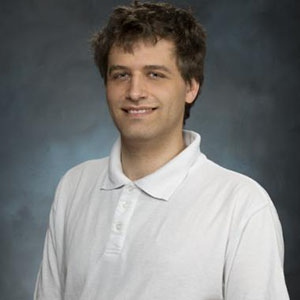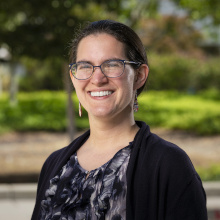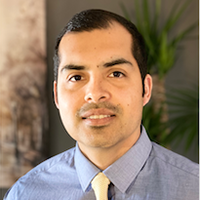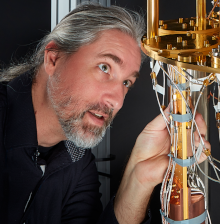Quantum Coherent Device Physics Group
Developing hardware, algorithms, and control for near-term applications in quantum information, sensing, and computing.
Our research aims to draw from and build a community around intersections in applied mathematics, computer science, quantum information, and device physics to make optimal use of near-term quantum hardware.
Our group has ongoing collaborations with related efforts at LLNL:
- Microscopic theory and multiscale device modeling
- Quantum sensing
- Quantum materials research
- Microwave photon counting
- Cryogenic detectors
Learn more about our group by exploring the topics below.
Research
We design solutions to, and explore synergies between, the following research challenges to enable efficient and reliable quantum algorithm development and to inform the quantum hardware co-design process:
- Gaining insight into conditions for optimal algorithm performance from quantum thermodynamic and quantum geometric information.
- Developing and applying powerful and scalable high-dimensional minimum-action methods to optimize gate sets and quantum algorithms.
- Realizing a systematic understanding of methods, limitations, and bounds on performance of passive stabilization of quantum dynamical flows and manifolds.
- Gaining insight into the instantaneous information content as well as the computational cost associated with extracting information from quantum algorithms as a function of run time.
- Developing classical machine-learning-based approaches to optimal extraction of quantum resultants.
- Developing self-consistent criteria for, and faithful read-out methods of, target variables in quantum simulators for verification and validation of simulation results.
The “Beyond Moore’s Law” effort evaluates the potential of the National Nuclear Security Administration’s (NNSA’s) Defense Programs’ applications of computing technologies that go beyond Moore’s Law scaling and Von Neumann architectures. The Advanced Simulation and Computing (ASC) program investigates the application of non-CMOS-based logical devices, as well as quantum and neuromorphic computing algorithms and hardware, for NNSA computing needs. The goal is to gain a detailed understanding and investigate the best technical approaches and benefits of these emerging technologies for NNSA applications and a roadmap for their integration into ASC computing platforms.
The objective of the quantum computing program is to provide a pathway for exploring quantum computing for ASC applications, including applications that work and evaluation of emerging hardware. The scope of this project includes research, development, and evaluation of prototype computing systems and algorithms, as well as developing potential industry and academic collaborations.
Quantum coherent devices offer the potential for unprecedented precision in sensing and the ability to directly simulate quantum phenomena that have no known efficient classical algorithms. Such devices include quantum bits (the fundamental units for quantum computing systems), microwave resonators (a type of superconducting photon detector), superconducting quantum interference devices (very-sensitive magnetometers used to measure extremely subtle magnetic fields), single-electron transistors, and single-photon detectors. The performance of such devices is largely limited by resonant couplings to low-energy states in the constituent materials (i.e., materials-based sources of noise). Overcoming this limitation requires that subtle forms of noise from decoherence in these systems be understood and controlled. This project will likely make a significant contribution to that understanding and control.
We intend to build a robust capability to design, fabricate, and characterize quantum coherent devices for applications in sensing and analog quantum simulation. We will then carry out a series of experiments designed to probe the fundamental limits of noise in these systems. Finally, we will apply these capabilities to develop a next-generation, superconducting quantum-bit-based detector designed to detect hypothetical dark-matter elementary particles called axions. Dark matter is estimated to make up about 23% of the energy density of the universe, with the rest being ordinary matter and a mysterious, repulsive, dark energy.
This research received support from the LLNL Laboratory Directed Research and Development Program (16-SI-004).
For more information, see “Additive Manufacturing Meets Quantum.”
The mission of the Fusion Energy Sciences (FES) program “to bring a star to earth” holds promise for solving energy needs for the foreseeable future.
This goal is one of the most challenging endeavors ever undertaken by humankind and quantum computing will be core to its success. By improving quantum algorithms, our work will deliver improvements in measurement sensitivity, information processing, and computing power to enable FES's mission.
Learn More About Fusion Energy Sciences High-performance Computing Code →
Quantum computing relies on sophisticated superconducting devices. Although those devices are achieving longer and longer coherence times, materials noise and loss processes nevertheless exhibit quantum effects that complicate and even spoil quantum simulations.
We're working to get better insight into the materials that affect quantum information systems by characterizing a selection of quantum device materials with a newly developed sensor that can extract information about μeV energy scale defects and inform quantum hardware optimization.
This modeling will allow for a detailed microscopic understanding of coupled defects, their interactions, emergent dynamics, and ultimate effect on a quantum circuit.
Learn More About Detecting the Material Origin of μeV Energy Scale Defects →
Innovations in quantum processing units are demonstrating quantum computing's viability. But as promising as that new hardware is, it's still subject to noise generated by uncontrolled environmental interactions. We're working to limit and harness that noise to design algorithms that use present-day tech to simulate the interaction of quantum particles.
Atomic nuclei are the core of matter and the fuel of stars. As if that weren't enough to captivate physicists, these collections of protons and neutrons are also archetypal quantum many-body systems that give rise to remarkable collective phenomena.
Our innovative approach to the many-nucleon problem describes the interaction of two neutrons via infinitesimal time steps that combine classical and quantum computing to propagate a simulation.
From simulating quantum phenomena to speeding up complex calculations to ultra-precise sensing, quantum computing has incredible potential.
While standard approaches to solid-state systems sacrifice sensitivity in an attempt to reduce the impact of environmental noise, we think there's a better way.
We hypothesize that tackling decoherence head-on by removing its physical sources would open the door to a wide range of approaches for scaling up quantum computation devices, while also extending coherence times.
Learn More Quantum Probes of the Materials Origins of Decoherence →
The Department of Energy’s (DOE’s) Office of Advanced Scientific Computing Research is investing in multidisciplinary teams with the goal of initiating an exploration of the suitability of various implementations of quantum computing hardware for science applications. These teams will lay the foundation for a codesign effort to ensure that architectures well-suited for DOE target applications are developed and that major DOE scientific problems can take advantage of the emerging architectures for quantum computing. Co-design refers to a computer system design process in which scientific problem requirements influence architecture design and technology and constraints inform formulation and design of algorithms and software.
It is anticipated that teams will focus on experimental efforts to explore a variety of hardware approaches ranging from different schemes for qubit connectivity to quantum/classical coprocessors and quantum accelerators for classical high-performance computing (HPC). Successful teams will conduct internal research to develop meaningful metrics for evaluating the suitability of selected quantum computing hardware for science applications and collaborate externally with researchers working to develop applications and algorithms relevant to DOE’s science and energy mission.
Quantum coherent computing technologies, though currently far from practical universal computation, now have the requisite coherence times, logical operation fidelities, and circuit topologies to perform specialized computations (for example, quantum simulations) relevant for fundamental research in molecular and materials science, numerical optimization, and high-energy physics, to name a few areas. In light of these recent advances, exploration of how these technologies can be integrated into the HPC community is timely.
We will deploy a flexible architecture to tackle key problems in these disciplines and will naturally establish mutually beneficial collaborations with existing DOE computational science communities. As the technologies proposed in our testbed mature, they have the potential to ultimately exceed the computing power promised by even the DOE Exascale Computing Project.
The classical-quantum interface is a key part of any quantum computer, but this meshing of technologies can impact both the quality of the data researchers can gather and the size and scale of quantum computing devices.
To improve the performance and scalability of superconducting quantum computing systems, we're building a new classical-quantum interface based on radio frequency (RF) photonics that should enable faster gates (quantum logical operations) without sacrificing coherence.
Facilities
Our researchers utilize world-class scientific capabilities and modern high-performance computing facilities to support Laboratory programs. Listed below are LLNL’s state-of-the-art capabilities commonly used by our group.
- Center for Micro- and Nanotechnology (CMNT)
- High-Performance Computing
- Quantum Coherent Device Laboratory
Featured Publications
- H. Y. Wong, P. Dhillon, K. M. Beck, and Y. J. Rosen, A Simulation Methodology for Superconducting Qubit Readout Fidelity, Solid-State Electronics 201, 108582 (2023).
- Z. Peng, D. Appelo, N. A. Petersson, F. Garcia, and Y. Cho, Mathematical Approaches for Characterization, Control, Calibration and Validation of a Quantum Computing Device, arXiv:2301.10712 (2023).
- C.-H. Liu, A. Ballard, D. Olaya, D. R. Schmidt, J. Biesecker, T. Lucas, J. Ullom, S. Patel, O. Rafferty, and A. Opremcak, Single Flux Quantum-Based Digital Control of Superconducting Qubits in a Multi-Chip Module, arXiv:2301.05696 (2023).
- I. Joseph, Y. Shi, M. Porter, A. Castelli, V. Geyko, F. Graziani, S. Libby, and J. DuBois, Quantum Computing for Fusion Energy Science Applications, Physics of Plasmas 30, 010501 (2023).
- L. D. Alegria, D. M. Tennant, K. R. Chaves, J. R. Lee, S. R. O’Kelley, Y. J. Rosen, and J. L. DuBois, Two-Level Systems in Nucleated and Non-Nucleated Epitaxial Alpha-Tantalum Films, arXiv:2301.10306 (2023).
- Q. Yu, A. M. Alonso, J. Caminiti, K. M. Beck, R. T. Sutherland, D. Leibfried, K. J. Rodriguez, M. Dhital, B. Hemmerling, and H. Häffner, Feasibility Study of Quantum Computing Using Trapped Electrons, Phys. Rev. A 105, 022420 (2022).
- L. Yu, S. Matityahu, Y. J. Rosen, C.-C. Hung, A. Maksymov, A. L. Burin, M. Schechter, and K. D. Osborn, Experimentally Revealing Anomalously Large Dipoles in the Dielectric of a Quantum Circuit, Scientific Reports 12, 16960 (2022).
- F. Turro, A. Roggero, V. Amitrano, P. Luchi, K. A. Wendt, J. L. DuBois, S. Quaglioni, and F. Pederiva, Imaginary-Time Propagation on a Quantum Chip, Physical Review A 105, 022440 (2022).
- D. M. Tennant, L. A. Martinez, K. M. Beck, S. R. O’Kelley, C. D. Wilen, R. McDermott, J. L. DuBois, and Y. J. Rosen, Low-Frequency Correlated Charge-Noise Measurements across Multiple Energy Transitions in a Tantalum Transmon, PRX Quantum 3, 030307 (2022).
- R. T. Sutherland, Q. Yu, K. M. Beck, and H. Häffner, One- and Two-Qubit Gate Infidelities Due to Motional Errors in Trapped Ions and Electrons, Phys. Rev. A 105, 022437 (2022).
- D.-X. Qu, J. J. Cuozzo, N. E. Teslich, K. G. Ray, Z. Dai, T. T. Li, G. F. Chapline, J. L. DuBois, and E. Rossi, Phase-Slip Lines and Anomalous Josephson Effects in a Tungsten Clusters-Topological Insulator Microbridge, arXiv:2301.00086 (2022).
- S. Pereverzev, G. Carosi, and V. Li, Superconducting Nanowire Single-Photon Detectors and Effect of Accumulation and Unsteady Releases of Excess Energy in Materials, arXiv:2204.01919, (2022).
- L. Martinez, Z. Peng, D. Appelö, D. Tennant, N. A. Petersson, J. DuBois, and Y. Rosen, Noise-Specific Beats in the Higher-Level Ramsey Curves of a Transmon Qubit, arXiv:2211.06531 (2022).
- P. Luchi, P. E. Trevisanutto, A. Roggero, J. L. DuBois, Y. J. Rosen, F. Turro, V. Amitrano, and F. Pederiva, Enhancing Qubit Readout with Autoencoders, arXiv:2212.00080 (2022).
- A. J. Goldschmidt, J. L. DuBois, S. L. Brunton, and J. N. Kutz, Model Predictive Control for Robust Quantum State Preparation, Quantum 6, 837 (2022).
- H. Dhillon, Y. J. Rosen, K. Beck, and H. Y. Wong, Simulation of Single-Shot Qubit Readout of a 2-Qubit Superconducting System with Noise Analysis, IEEE (2022).
- Y. Cho, D. Jasrasaria, K. G. Ray, D. M. Tennant, V. Lordi, J. L. DuBois, and Y. J. Rosen, Simulating Noise on a Quantum Processor: Interactions between a Qubit and Resonant Two-Level System Bath, arXiv:2211.08535 (2022).
- BREAD Collaboration et al., Broadband Solenoidal Haloscope for Terahertz Axion Detection, Phys. Rev. Lett. 128, 131801 (2022).
- T. Braine, G. Rybka, A. A. Baker, J. Brodsky, G. Carosi, N. Du, N. Woollett, S. Knirck, and M. Jones, Multi-Mode Analysis of Surface Losses in a Superconducting Microwave Resonator in High Magnetic Fields, arXiv:2208.11799, 2022.
- C. D. Wilen, et al, Correlated Charge Noise and Relaxation Errors in Superconducting Qubits, Nature 594, 7863 (2021).
- H. Wang, S. Singh, C. McRae, J. Bardin, S. Lin, N. Messaoudi, A. Castelli, Y. Rosen, E. Holland, and D. Pappas, Cryogenic Single-Port Calibration for Superconducting Microwave Resonator Measurements, Quantum Science and Technology 6, 035015 (2021).
- N. A. Paterson, D. Appelo, J. L. DuBois, Y. J. Rosen, K. M. Beck, and K. A. Wendt, Optimal Control of Coupled Quantum Systems Using Super-Computing Resources, Lawrence Livermore National Lab. (LLNL), Livermore, CA (United States), 2021.
- Y. Shi, A. R. Castelli, X. Wu, I. Joseph, V. Geyko, F. R. Graziani, S. B. Libby, J. B. Parker, Y. J. Rosen, and L. A. Martinez, Simulating Non-Native Cubic Interactions on Noisy Quantum Machines, Physical Review A 103, 062608 (2021).
- Y. Rosen, L. Martinez, K. M Beck, S. Quaglioni, and J. L DuBois, Quantum Workforce Development at Lawrence Livermore National Laboratory, Lawrence Livermore National Lab. (LLNL), Livermore, CA (United States), 2021.
- Y. Rosen, K. Beck, K. Chaves, Y. Cho, G. Carosi, J. L DuBois, J. Harke, S. Libby, V. Lordi, and N. Petersson, Request for Information: Access to Quantum Systems, Lawrence Livermore National Lab. (LLNL), Livermore, CA (United States), 2021.
- N. A. Petersson, S. Guenther, and J. Dubois, Quandary: An Open-Source Package for High-Performance Optimal Control of Open Quantum Systems, Lawrence Livermore National Lab. (LLNL), Livermore, CA (United States), 2021.
- M. Molina-Ruiz, Y. Rosen, H. Jacks, M. Abernathy, T. Metcalf, X. Liu, J. DuBois, and F. Hellman, Origin of Mechanical and Dielectric Losses from Two-Level Systems in Amorphous Silicon, Physical Review Materials 5, 035601 (2021).
- S. Günther, N. A. Petersson, and J. L. DuBois, Quantum Optimal Control for Pure-State Preparation Using One Initial State, AVS Quantum Science 3, 043801 (2021).
- S. Günther, N. A. Petersson, and J. L. DuBois, Quandary: An Open-Source C++ Package for High-Performance Optimal Control of Open Quantum Systems, IEEE (2021).
- A. Goldschmidt, E. Kaiser, J. L. Dubois, S. L. Brunton, and J. N. Kutz, Bilinear Dynamic Mode Decomposition for Quantum Control, New Journal of Physics 23, 033035 (2021).
- K. R. Chaves, X. Wu, Y. J. Rosen, and J. L. DuBois, Nonlinear Signal Distortion Corrections through Quantum Sensing, Applied Physics Letters 118, 014001 (2021).
- K. Beck, Y. Rosen, J. DuBois, S. Quaglioni, and K. Wendt, White Box Access to Quantum Testbeds for Co-Design, Lawrence Livermore National Lab. (LLNL), Livermore, CA (United States), 2021.
- X. Wu, S. L. Tomarken, N. A. Petersson, L. A. Martinez, Y. J. Rosen, and J. L. DuBois, High-Fidelity Software-Defined Quantum Logic on a Superconducting Qudit, Physical Review Letters 125, 170502 (2020).
- J. E. Sharping, J. Pate, J. Parker, J. J. Thompson, L. A. Martinez, A. R. Castelli, and R. Y. Chiao, Joints and Shape Imperfections in High-Q 3D SRF Cavities for RF Optomechanics, Journal of Applied Physics 128, (2020).
- Y. Rosen, J. Dubois, E. T. Holland, and M. A. Horsley, Quantum Coherent Devices with Reduced Energy Dissipation (2020).
- L. A. Martinez, Y. J. Rosen, and J. L. DuBois, Improving Qubit Readout with Hidden Markov Models, Physical Review A 102, 062426 (2020).
- E. T. Holland, K. A. Wendt, K. Kravvaris, X. Wu, W. E. Ormand, J. L. DuBois, S. Quaglioni, and F. Pederiva, Optimal Control for the Quantum Simulation of Nuclear Dynamics, Physical Review A 101, 062307 (2020).
- J. DuBois, V. Lordi, Y. Rosen, and X. Wu, Request for the Establishment of Quantum Information Foundries, Lawrence Livermore National Lab. (LLNL), Livermore, CA (United States), 2020.
- A. Agrawal, D. Bowring, R. Bunker, L. Cardani, G. Carosi, C. Chang15, M. Cecchin, A. Chou, G. D’Imperio, and A. Dixit, Coupling Experiment and Simulation to Model Non-Equilibrium Quasiparticle Dynamics in Superconductors (2020).
- Y. J. Rosen, M. A. Horsley, S. E. Harrison, E. T. Holland, A. S. Chang, T. Bond, and J. L. DuBois, Protecting Superconducting Qubits from Phonon Mediated Decay, Applied Physics Letters 114, 202601 (2019).
- E. H. Lock, P. Xu, T. Kohler, L. Camacho, J. Prestigiacomo, Y. J. Rosen, and K. D. Osborn, Using Surface Engineering to Modulate Superconducting Coplanar Microwave Resonator Performance, IEEE Transactions on Applied Superconductivity 29, 1 (2019).
- V. Geyko, Using Grover’s Search Algorithm to Test a Three-Level Quantum Syste, Lawrence Livermore National Lab. (LLNL), Livermore, CA (United States), 2019.
- B. Christensen, C. Wilen, A. Opremcak, J. Nelson, F. Schlenker, C. Zimonick, L. Faoro, L. Ioffe, Y. Rosen, and J. DuBois, Anomalous Charge Noise in Superconducting Qubits, Physical Review B 100, 140503 (2019).
- D.-X. Qu, N. E. Teslich, Z. Dai, G. F. Chapline, T. Schenkel, S. R. Durham, and J. Dubois, Onset of a Two-Dimensional Superconducting Phase in a Topological-Insulator–Normal-Metal Bi 1− x Sb x/Pt Junction Fabricated by Ion-Beam Techniques, Physical Review Letters 121, 037001 (2018).
- D.-X. Qu, X. Che, X. Kou, L. Pan, J. Crowhurst, M. R. Armstrong, J. Dubois, K. L. Wang, and G. F. Chapline, Anomalous Helicity-Dependent Photocurrent in the Topological Insulator (Bi 0.5 Sb 0.5) 2 Te 3 on a GaAs Substrate, Physical Review B 97, 045308 (2018).
- E. H. Lock, P. Xu, T. Kohler, Y. Rosen, A. Ramanayaka, and K. D. Osborn, Effect of Chemical and Plasma Functionalization on the Performance of Microwave Resonators, IEEE (2017).
- E. T. Holland, Y. J. Rosen, N. Materise, N. Woollett, T. Voisin, Y. M. Wang, S. G. Torres, J. Mireles, G. Carosi, and J. L. DuBois, High-Kinetic Inductance Additive Manufactured Superconducting Microwave Cavity, Applied Physics Letters 111, 202602 (2017).
- J. C. Corbo, J. L. DuBois, and K. B. Whaley, Number-Squeezed and Fragmented States of Strongly Interacting Bosons in a Double Well, Physical Review A 96, 053627 (2017).
- N. Adelstein, D. Lee, J. L. DuBois, K. G. Ray, J. B. Varley, and V. Lordi, Magnetic Stability of Oxygen Defects on the SiO2 Surface, AIP Advances 7, 025110 (2017).
- Y. J. Rosen, M. S. Khalil, A. L. Burin, and K. D. Osborn, Random-Defect Laser: Manipulating Lossy Two-Level Systems to Produce a Circuit with Coherent Gain, Physical Review Letters 116, 163601 (2016).
- D. Lee, J. L. DuBois, and V. Lordi, Identification of the Local Sources of Paramagnetic Noise in Superconducting Qubit Devices Fabricated on Α− Al 2 O 3 Substrates Using Density-Functional Calculations, Physical Review Letters 112, 017001 (2014).
Related Links
Collaborators
- Quantum Nanoelectronics Lab, University of California, Berkeley
- Jonathan Carter, Lawrence Berkeley National Laboratory
- McDermott Group, University of Wisconsin, Madison
- Schuster Lab, University of Chicago
- Kevin Osborn, Laboratory for Physical Sciences
FY18 Sponsors
- NNSA Advanced Simulation and Computing
- Advanced Scientific Computing Research










